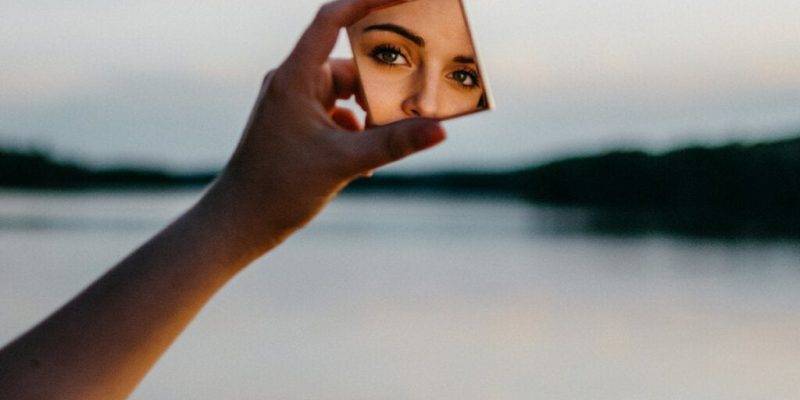Have you ever thought about how you see yourself? This is what self-image is. It’s defined as ‘ an internal mirror of one’s own person’.
Self-image involves a mental representation of how we are, inside and out.
Self-image is something that you started to build from birth and it feeds on your experiences. Based on your self-image, you direct your attention to your weaknesses or strengths. In this article, we’ll tell you more about the concept and its characteristics. In addition, we’ll suggest four key ideas to help enhance it.
Self-image
Self-image is defined as “the idea one has of one’s abilities, appearance, and personality”. As a rule, it’s stable, although it can change slightly over time and with certain experiences.
Self-image is configured through how you see yourself, both on a physical level (height, weight, hair color, etc.) and on an intellectual, social, and personal level. This mental representation influences how you treat yourself, your self-esteem, and also your self-concept.
Characteristics of self-image
Self-image can be positive or negative. It doesn’t remain static over time, although it does usually have a fairly solid base. We might talk about a more or less healthy self-image. When it’s healthy, it means that it’s realistic and consistent with what you are and what you feel.
So, what are the characteristics of a healthy self-image? Here are some of them:
- Having a realistic conception of yourself (self-concept).
- Trusting yourself.
- Treating yourself with respect and love.
- Being aware of your flaws, but also of your strengths.
- Having a positive view of yourself.
- Loving how you are, inside and out.
How to improve your self-image
Although your self-image is quite stable, you can improve it. Here’s how.
Making comparisons
We all compare ourselves. It’s inevitable and quite normal. In fact, according to social comparison theory, developed by psychologist Leon Festinger in 1954, we evaluate our own abilities, opinions, and abilities and compare them to those of others. We mainly do it in situations of uncertainty.
We also compare ourselves to people who are similar to us. When we compare our abilities, we tend to do so with someone we consider to be better than us because of the desire to continue developing ourselves.
We often compare ourselves with people who think differently. However, when faced with situations that generate anxiety, we compare ourselves with people who are going through the same thing, seeking understanding.
Find your best version
If you’re not making comparisons for the desire to improve or learn, comparing is useless. Moreover, it often generates discomfort, jealousy, and anxiety. Therefore, when building your self-image, make sure you only pay attention to your progress.
Evaluate how you are and establish the criteria you’re going to use to compare the different versions of yourself. Indeed, it’s more constructive to compare yourself with your best version, or with the one you want to aspire to, than with another person.
Know yourself
Self-image is built through experiences with yourself and with others. The more you know yourself, the more realistic the vision you have of yourself will be.
Therefore, we encourage you to get to know yourself and invest time in yourself. This will help you to better understand your way of being and the way you react to life events. From here, you’ll be able to build an increasingly healthy self-image.
Take care of your internal dialogue
Internal dialogue concerns how you talk to yourself. Do you speak positively or negatively to yourself? Do you pay attention to your inner language?
Bear in mind that your self-image is also built through this internal dialogue. Therefore, it’s important that it’s healthy, consistent, and realistic.
Try not to be too critical of yourself. Reinforce the things that you do well and give yourself positive messages. From there, you can develop the image you have of yourself.
“Our self-respect tracks our choices. Every time we act in harmony with our authentic self and our heart, we earn our respect. It is that simple. Every choice matters.”
-Dan Coppersmith-

Identify your strengths
Self-image is also built from the strengths that you’re able to identify in yourself. This includes your skills and abilities. Learn to detect them and make a list of them. Above all, be aware of them.
This will help you build a more realistic image of yourself and, above all, look at yourself with love. It doesn’t mean that you should ignore your own faults. Obviously, you know that they’re there, but don’t give them more prominence than necessary.
So, what image do you have of yourself? Do you think you recognize how you really are and are proud of yourself? What do you feel when you look in the mirror ? Are you able to recognize yourself?
As you can see, self-image is linked to your ability to connect with your true essence. It involves recognizing yourself as a valuable person, and realizing that you’re vulnerable at certain times.
“If you could only sense how important you are to the lives of those you meet; how important you can be to the people you may never even dream of. There is something of yourself that you leave at every meeting with another person.”
-Fred Rogers-
The post Self-Image: What It Is and How You Can Improve It appeared first on Exploring your mind.



















Comments